Social and Political Determinants of Health in Adelaide, Australia
VerifiedAdded on 2020/03/16
|8
|1647
|150
Report
AI Summary
This report examines the social and political determinants of health, focusing on health inequalities in two Adelaide suburbs: Playford and Adelaide Hills. It explores the conceptual model of health, social gradient, and key social determinants like employment, income, and access to services. The report analyzes health inequities, considering factors such as premature death rates, socioeconomic status, and cultural differences. It discusses the application of theories like psychosocial, materialistic, and neo-materialistic frameworks in understanding health disparities. Furthermore, the report highlights the importance of promoting health equity through interventions and community development programs, advocating for collaborative partnerships and increased awareness to reduce health inequalities and improve health outcomes within the community. References include works by Dahlgren & Whitehead, Batterham et al., and others.
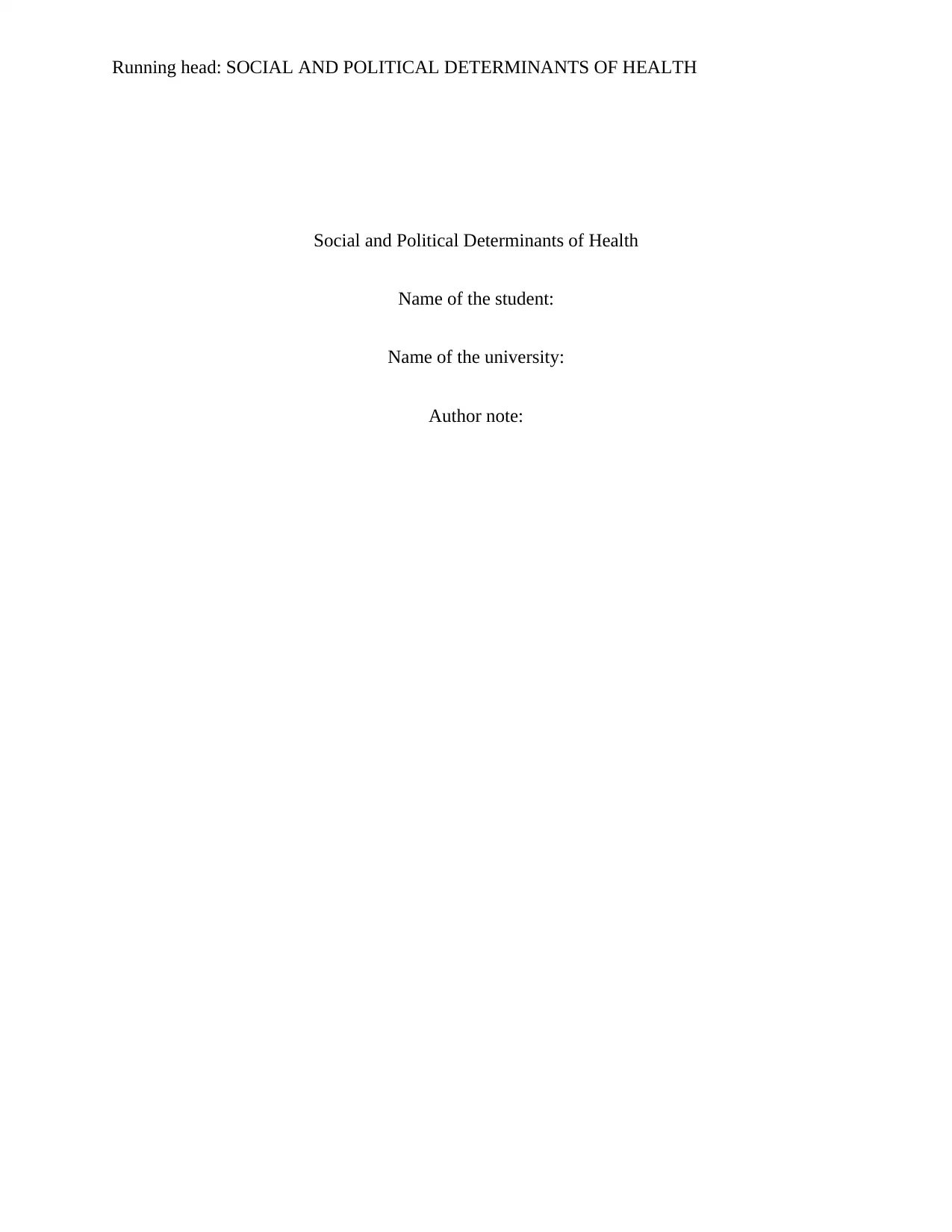
Running head: SOCIAL AND POLITICAL DETERMINANTS OF HEALTH
Social and Political Determinants of Health
Name of the student:
Name of the university:
Author note:
Social and Political Determinants of Health
Name of the student:
Name of the university:
Author note:
Paraphrase This Document
Need a fresh take? Get an instant paraphrase of this document with our AI Paraphraser
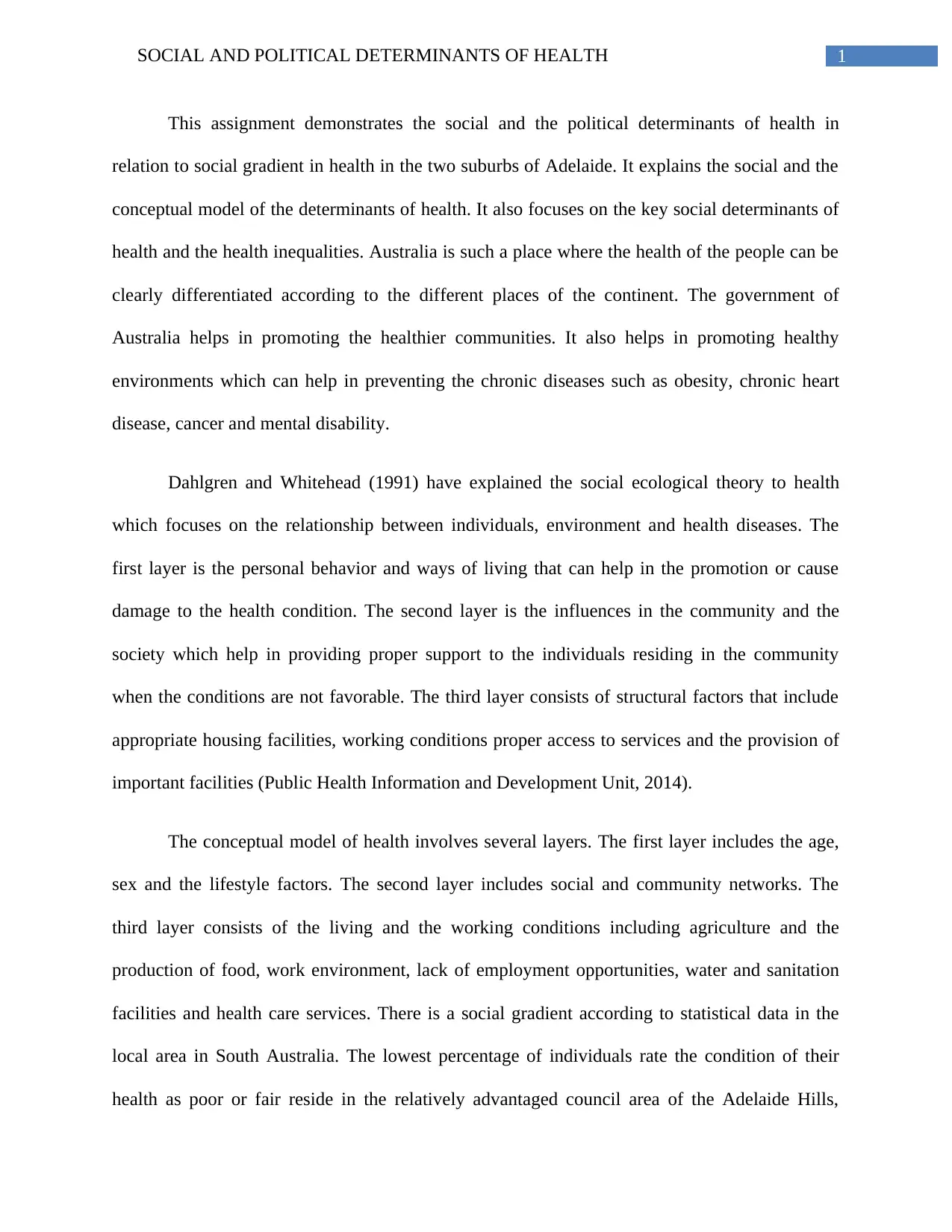
1SOCIAL AND POLITICAL DETERMINANTS OF HEALTH
This assignment demonstrates the social and the political determinants of health in
relation to social gradient in health in the two suburbs of Adelaide. It explains the social and the
conceptual model of the determinants of health. It also focuses on the key social determinants of
health and the health inequalities. Australia is such a place where the health of the people can be
clearly differentiated according to the different places of the continent. The government of
Australia helps in promoting the healthier communities. It also helps in promoting healthy
environments which can help in preventing the chronic diseases such as obesity, chronic heart
disease, cancer and mental disability.
Dahlgren and Whitehead (1991) have explained the social ecological theory to health
which focuses on the relationship between individuals, environment and health diseases. The
first layer is the personal behavior and ways of living that can help in the promotion or cause
damage to the health condition. The second layer is the influences in the community and the
society which help in providing proper support to the individuals residing in the community
when the conditions are not favorable. The third layer consists of structural factors that include
appropriate housing facilities, working conditions proper access to services and the provision of
important facilities (Public Health Information and Development Unit, 2014).
The conceptual model of health involves several layers. The first layer includes the age,
sex and the lifestyle factors. The second layer includes social and community networks. The
third layer consists of the living and the working conditions including agriculture and the
production of food, work environment, lack of employment opportunities, water and sanitation
facilities and health care services. There is a social gradient according to statistical data in the
local area in South Australia. The lowest percentage of individuals rate the condition of their
health as poor or fair reside in the relatively advantaged council area of the Adelaide Hills,
This assignment demonstrates the social and the political determinants of health in
relation to social gradient in health in the two suburbs of Adelaide. It explains the social and the
conceptual model of the determinants of health. It also focuses on the key social determinants of
health and the health inequalities. Australia is such a place where the health of the people can be
clearly differentiated according to the different places of the continent. The government of
Australia helps in promoting the healthier communities. It also helps in promoting healthy
environments which can help in preventing the chronic diseases such as obesity, chronic heart
disease, cancer and mental disability.
Dahlgren and Whitehead (1991) have explained the social ecological theory to health
which focuses on the relationship between individuals, environment and health diseases. The
first layer is the personal behavior and ways of living that can help in the promotion or cause
damage to the health condition. The second layer is the influences in the community and the
society which help in providing proper support to the individuals residing in the community
when the conditions are not favorable. The third layer consists of structural factors that include
appropriate housing facilities, working conditions proper access to services and the provision of
important facilities (Public Health Information and Development Unit, 2014).
The conceptual model of health involves several layers. The first layer includes the age,
sex and the lifestyle factors. The second layer includes social and community networks. The
third layer consists of the living and the working conditions including agriculture and the
production of food, work environment, lack of employment opportunities, water and sanitation
facilities and health care services. There is a social gradient according to statistical data in the
local area in South Australia. The lowest percentage of individuals rate the condition of their
health as poor or fair reside in the relatively advantaged council area of the Adelaide Hills,
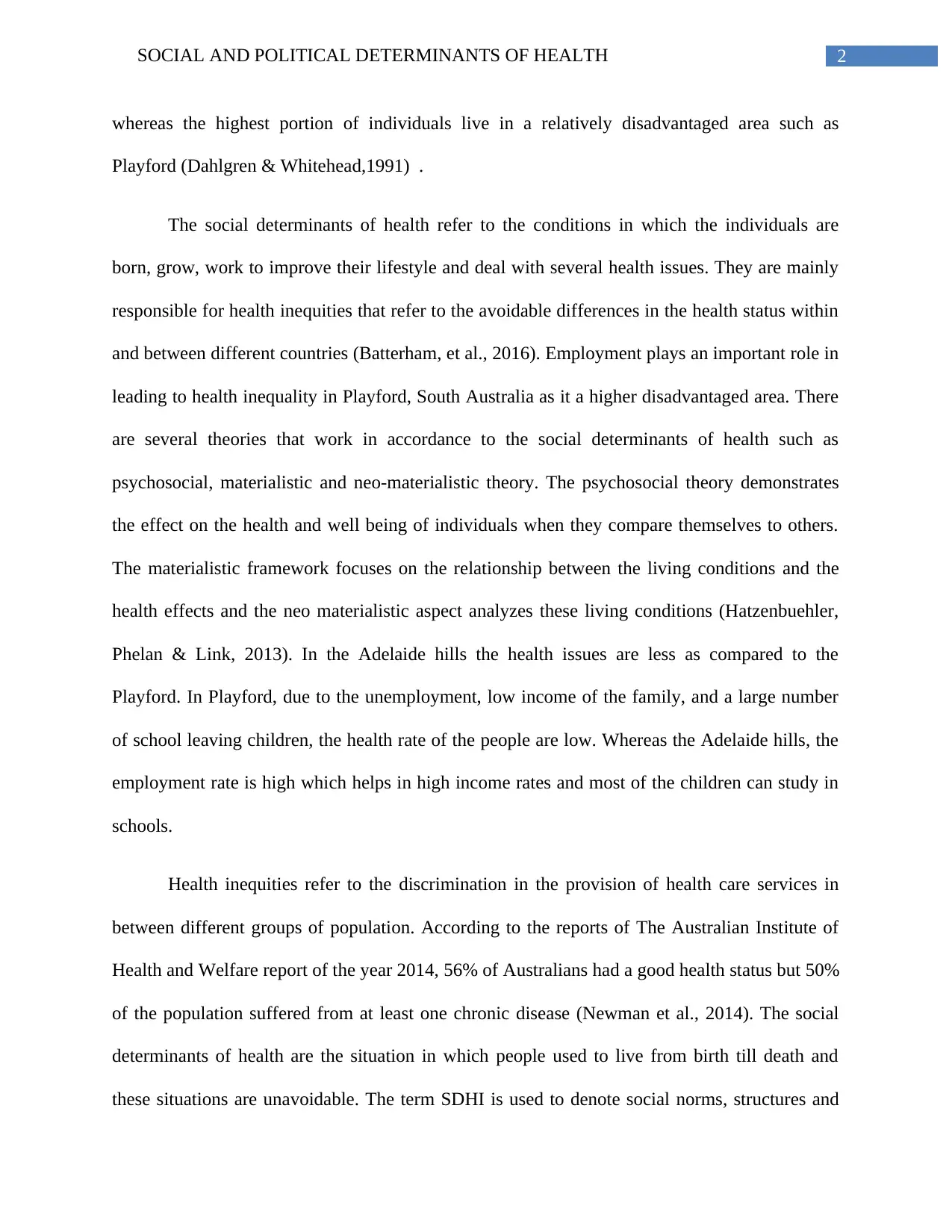
2SOCIAL AND POLITICAL DETERMINANTS OF HEALTH
whereas the highest portion of individuals live in a relatively disadvantaged area such as
Playford (Dahlgren & Whitehead,1991) .
The social determinants of health refer to the conditions in which the individuals are
born, grow, work to improve their lifestyle and deal with several health issues. They are mainly
responsible for health inequities that refer to the avoidable differences in the health status within
and between different countries (Batterham, et al., 2016). Employment plays an important role in
leading to health inequality in Playford, South Australia as it a higher disadvantaged area. There
are several theories that work in accordance to the social determinants of health such as
psychosocial, materialistic and neo-materialistic theory. The psychosocial theory demonstrates
the effect on the health and well being of individuals when they compare themselves to others.
The materialistic framework focuses on the relationship between the living conditions and the
health effects and the neo materialistic aspect analyzes these living conditions (Hatzenbuehler,
Phelan & Link, 2013). In the Adelaide hills the health issues are less as compared to the
Playford. In Playford, due to the unemployment, low income of the family, and a large number
of school leaving children, the health rate of the people are low. Whereas the Adelaide hills, the
employment rate is high which helps in high income rates and most of the children can study in
schools.
Health inequities refer to the discrimination in the provision of health care services in
between different groups of population. According to the reports of The Australian Institute of
Health and Welfare report of the year 2014, 56% of Australians had a good health status but 50%
of the population suffered from at least one chronic disease (Newman et al., 2014). The social
determinants of health are the situation in which people used to live from birth till death and
these situations are unavoidable. The term SDHI is used to denote social norms, structures and
whereas the highest portion of individuals live in a relatively disadvantaged area such as
Playford (Dahlgren & Whitehead,1991) .
The social determinants of health refer to the conditions in which the individuals are
born, grow, work to improve their lifestyle and deal with several health issues. They are mainly
responsible for health inequities that refer to the avoidable differences in the health status within
and between different countries (Batterham, et al., 2016). Employment plays an important role in
leading to health inequality in Playford, South Australia as it a higher disadvantaged area. There
are several theories that work in accordance to the social determinants of health such as
psychosocial, materialistic and neo-materialistic theory. The psychosocial theory demonstrates
the effect on the health and well being of individuals when they compare themselves to others.
The materialistic framework focuses on the relationship between the living conditions and the
health effects and the neo materialistic aspect analyzes these living conditions (Hatzenbuehler,
Phelan & Link, 2013). In the Adelaide hills the health issues are less as compared to the
Playford. In Playford, due to the unemployment, low income of the family, and a large number
of school leaving children, the health rate of the people are low. Whereas the Adelaide hills, the
employment rate is high which helps in high income rates and most of the children can study in
schools.
Health inequities refer to the discrimination in the provision of health care services in
between different groups of population. According to the reports of The Australian Institute of
Health and Welfare report of the year 2014, 56% of Australians had a good health status but 50%
of the population suffered from at least one chronic disease (Newman et al., 2014). The social
determinants of health are the situation in which people used to live from birth till death and
these situations are unavoidable. The term SDHI is used to denote social norms, structures and
⊘ This is a preview!⊘
Do you want full access?
Subscribe today to unlock all pages.

Trusted by 1+ million students worldwide
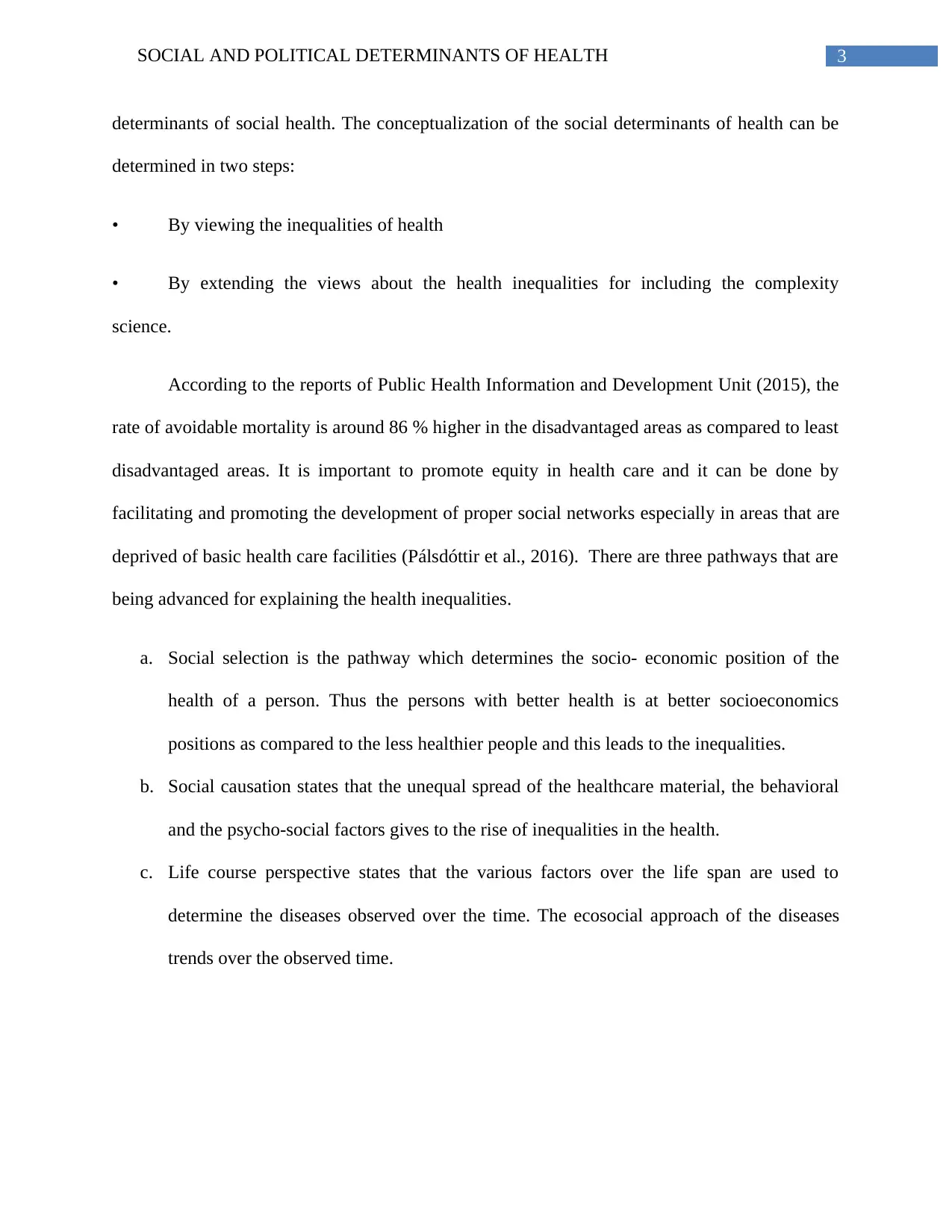
3SOCIAL AND POLITICAL DETERMINANTS OF HEALTH
determinants of social health. The conceptualization of the social determinants of health can be
determined in two steps:
• By viewing the inequalities of health
• By extending the views about the health inequalities for including the complexity
science.
According to the reports of Public Health Information and Development Unit (2015), the
rate of avoidable mortality is around 86 % higher in the disadvantaged areas as compared to least
disadvantaged areas. It is important to promote equity in health care and it can be done by
facilitating and promoting the development of proper social networks especially in areas that are
deprived of basic health care facilities (Pálsdóttir et al., 2016). There are three pathways that are
being advanced for explaining the health inequalities.
a. Social selection is the pathway which determines the socio- economic position of the
health of a person. Thus the persons with better health is at better socioeconomics
positions as compared to the less healthier people and this leads to the inequalities.
b. Social causation states that the unequal spread of the healthcare material, the behavioral
and the psycho-social factors gives to the rise of inequalities in the health.
c. Life course perspective states that the various factors over the life span are used to
determine the diseases observed over the time. The ecosocial approach of the diseases
trends over the observed time.
determinants of social health. The conceptualization of the social determinants of health can be
determined in two steps:
• By viewing the inequalities of health
• By extending the views about the health inequalities for including the complexity
science.
According to the reports of Public Health Information and Development Unit (2015), the
rate of avoidable mortality is around 86 % higher in the disadvantaged areas as compared to least
disadvantaged areas. It is important to promote equity in health care and it can be done by
facilitating and promoting the development of proper social networks especially in areas that are
deprived of basic health care facilities (Pálsdóttir et al., 2016). There are three pathways that are
being advanced for explaining the health inequalities.
a. Social selection is the pathway which determines the socio- economic position of the
health of a person. Thus the persons with better health is at better socioeconomics
positions as compared to the less healthier people and this leads to the inequalities.
b. Social causation states that the unequal spread of the healthcare material, the behavioral
and the psycho-social factors gives to the rise of inequalities in the health.
c. Life course perspective states that the various factors over the life span are used to
determine the diseases observed over the time. The ecosocial approach of the diseases
trends over the observed time.
Paraphrase This Document
Need a fresh take? Get an instant paraphrase of this document with our AI Paraphraser
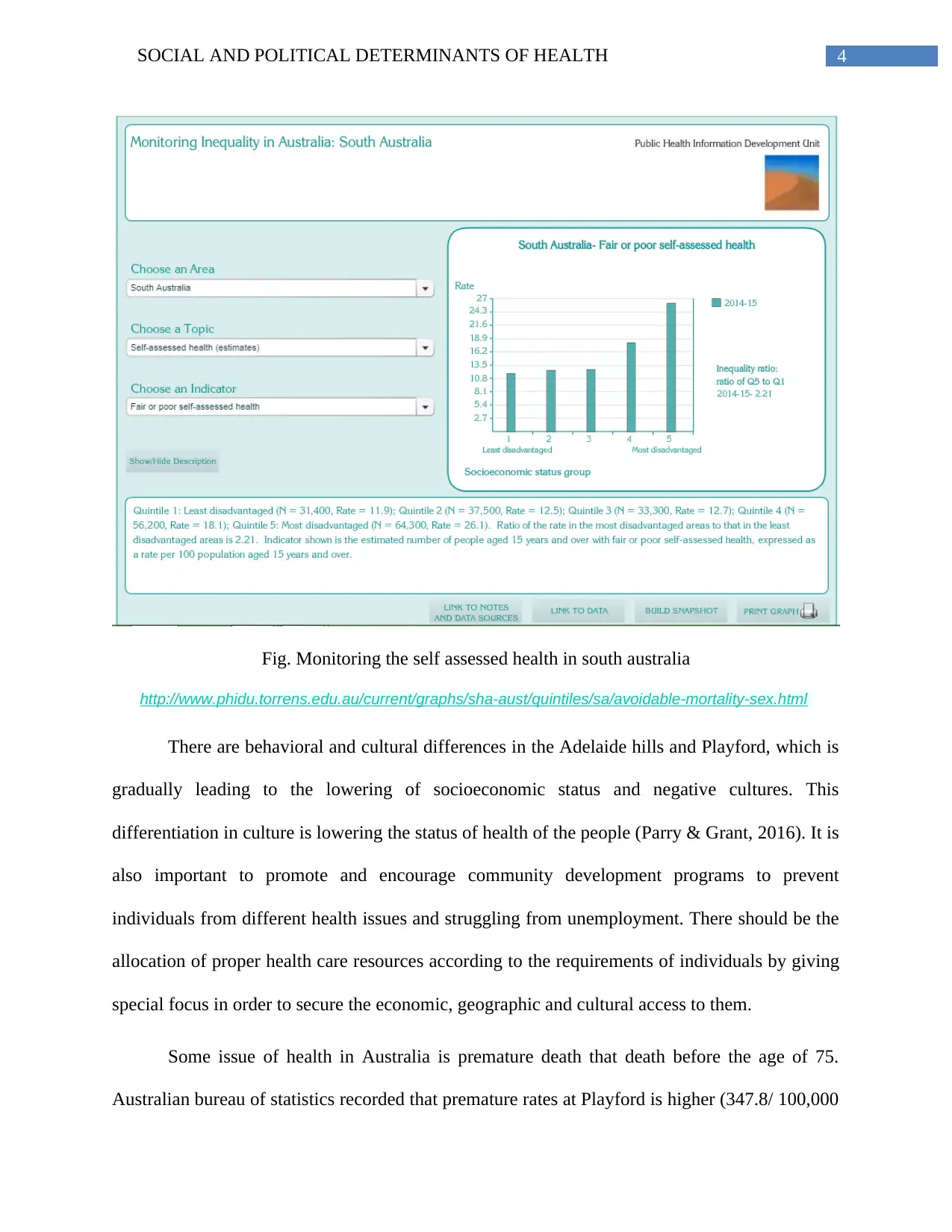
4SOCIAL AND POLITICAL DETERMINANTS OF HEALTH
Fig. Monitoring the self assessed health in south australia
http://www.phidu.torrens.edu.au/current/graphs/sha-aust/quintiles/sa/avoidable-mortality-sex.html
There are behavioral and cultural differences in the Adelaide hills and Playford, which is
gradually leading to the lowering of socioeconomic status and negative cultures. This
differentiation in culture is lowering the status of health of the people (Parry & Grant, 2016). It is
also important to promote and encourage community development programs to prevent
individuals from different health issues and struggling from unemployment. There should be the
allocation of proper health care resources according to the requirements of individuals by giving
special focus in order to secure the economic, geographic and cultural access to them.
Some issue of health in Australia is premature death that death before the age of 75.
Australian bureau of statistics recorded that premature rates at Playford is higher (347.8/ 100,000
Fig. Monitoring the self assessed health in south australia
http://www.phidu.torrens.edu.au/current/graphs/sha-aust/quintiles/sa/avoidable-mortality-sex.html
There are behavioral and cultural differences in the Adelaide hills and Playford, which is
gradually leading to the lowering of socioeconomic status and negative cultures. This
differentiation in culture is lowering the status of health of the people (Parry & Grant, 2016). It is
also important to promote and encourage community development programs to prevent
individuals from different health issues and struggling from unemployment. There should be the
allocation of proper health care resources according to the requirements of individuals by giving
special focus in order to secure the economic, geographic and cultural access to them.
Some issue of health in Australia is premature death that death before the age of 75.
Australian bureau of statistics recorded that premature rates at Playford is higher (347.8/ 100,000
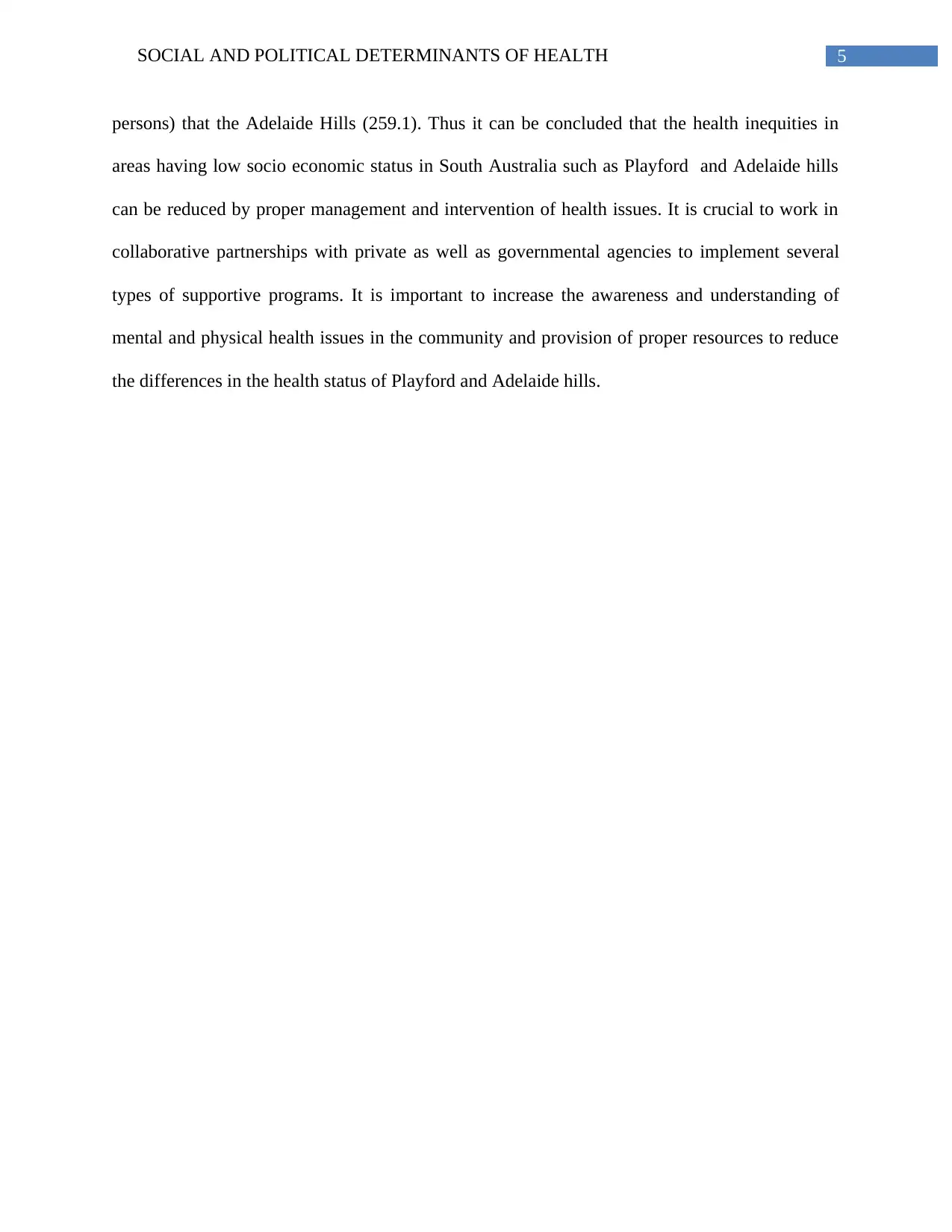
5SOCIAL AND POLITICAL DETERMINANTS OF HEALTH
persons) that the Adelaide Hills (259.1). Thus it can be concluded that the health inequities in
areas having low socio economic status in South Australia such as Playford and Adelaide hills
can be reduced by proper management and intervention of health issues. It is crucial to work in
collaborative partnerships with private as well as governmental agencies to implement several
types of supportive programs. It is important to increase the awareness and understanding of
mental and physical health issues in the community and provision of proper resources to reduce
the differences in the health status of Playford and Adelaide hills.
persons) that the Adelaide Hills (259.1). Thus it can be concluded that the health inequities in
areas having low socio economic status in South Australia such as Playford and Adelaide hills
can be reduced by proper management and intervention of health issues. It is crucial to work in
collaborative partnerships with private as well as governmental agencies to implement several
types of supportive programs. It is important to increase the awareness and understanding of
mental and physical health issues in the community and provision of proper resources to reduce
the differences in the health status of Playford and Adelaide hills.
⊘ This is a preview!⊘
Do you want full access?
Subscribe today to unlock all pages.

Trusted by 1+ million students worldwide
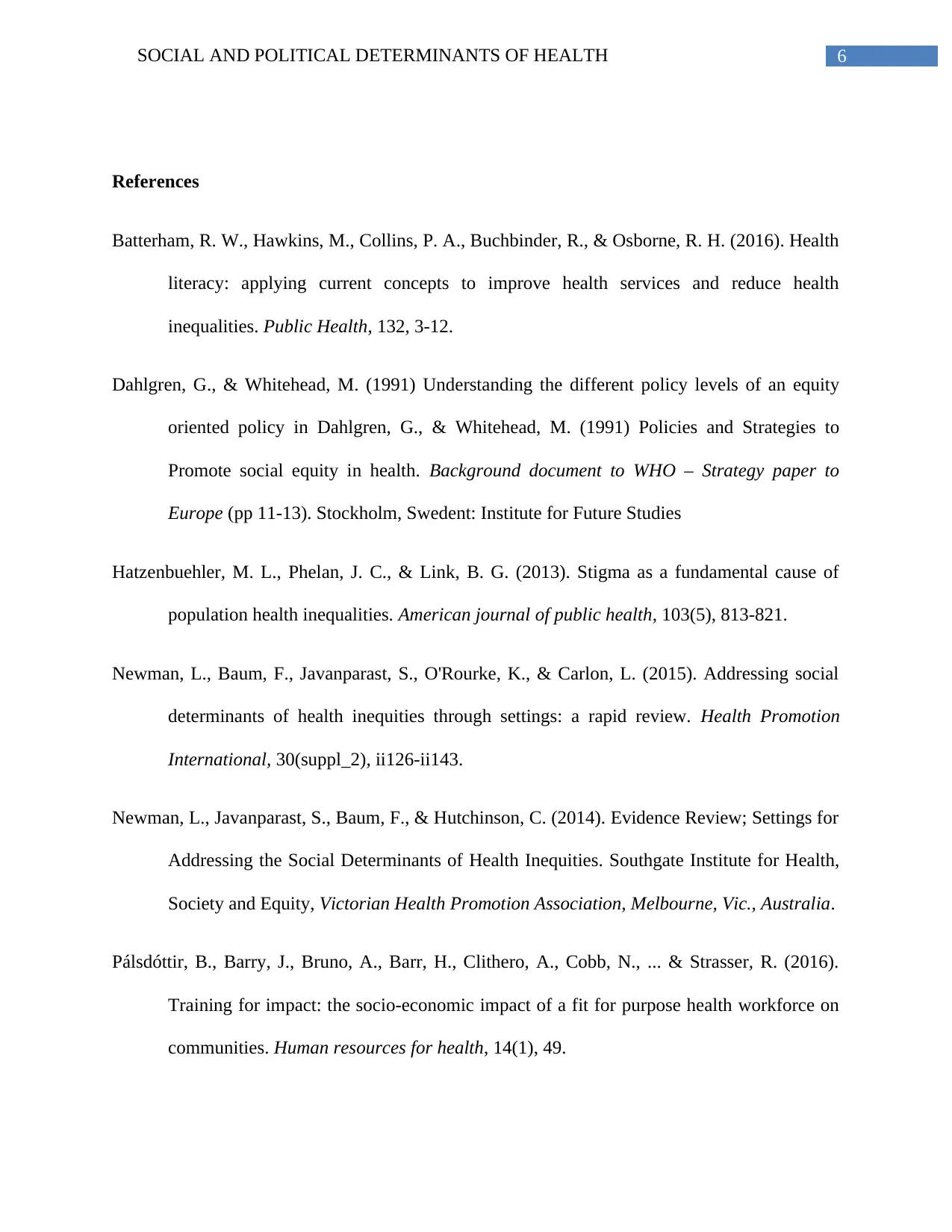
6SOCIAL AND POLITICAL DETERMINANTS OF HEALTH
References
Batterham, R. W., Hawkins, M., Collins, P. A., Buchbinder, R., & Osborne, R. H. (2016). Health
literacy: applying current concepts to improve health services and reduce health
inequalities. Public Health, 132, 3-12.
Dahlgren, G., & Whitehead, M. (1991) Understanding the different policy levels of an equity
oriented policy in Dahlgren, G., & Whitehead, M. (1991) Policies and Strategies to
Promote social equity in health. Background document to WHO – Strategy paper to
Europe (pp 11-13). Stockholm, Swedent: Institute for Future Studies
Hatzenbuehler, M. L., Phelan, J. C., & Link, B. G. (2013). Stigma as a fundamental cause of
population health inequalities. American journal of public health, 103(5), 813-821.
Newman, L., Baum, F., Javanparast, S., O'Rourke, K., & Carlon, L. (2015). Addressing social
determinants of health inequities through settings: a rapid review. Health Promotion
International, 30(suppl_2), ii126-ii143.
Newman, L., Javanparast, S., Baum, F., & Hutchinson, C. (2014). Evidence Review; Settings for
Addressing the Social Determinants of Health Inequities. Southgate Institute for Health,
Society and Equity, Victorian Health Promotion Association, Melbourne, Vic., Australia.
Pálsdóttir, B., Barry, J., Bruno, A., Barr, H., Clithero, A., Cobb, N., ... & Strasser, R. (2016).
Training for impact: the socio-economic impact of a fit for purpose health workforce on
communities. Human resources for health, 14(1), 49.
References
Batterham, R. W., Hawkins, M., Collins, P. A., Buchbinder, R., & Osborne, R. H. (2016). Health
literacy: applying current concepts to improve health services and reduce health
inequalities. Public Health, 132, 3-12.
Dahlgren, G., & Whitehead, M. (1991) Understanding the different policy levels of an equity
oriented policy in Dahlgren, G., & Whitehead, M. (1991) Policies and Strategies to
Promote social equity in health. Background document to WHO – Strategy paper to
Europe (pp 11-13). Stockholm, Swedent: Institute for Future Studies
Hatzenbuehler, M. L., Phelan, J. C., & Link, B. G. (2013). Stigma as a fundamental cause of
population health inequalities. American journal of public health, 103(5), 813-821.
Newman, L., Baum, F., Javanparast, S., O'Rourke, K., & Carlon, L. (2015). Addressing social
determinants of health inequities through settings: a rapid review. Health Promotion
International, 30(suppl_2), ii126-ii143.
Newman, L., Javanparast, S., Baum, F., & Hutchinson, C. (2014). Evidence Review; Settings for
Addressing the Social Determinants of Health Inequities. Southgate Institute for Health,
Society and Equity, Victorian Health Promotion Association, Melbourne, Vic., Australia.
Pálsdóttir, B., Barry, J., Bruno, A., Barr, H., Clithero, A., Cobb, N., ... & Strasser, R. (2016).
Training for impact: the socio-economic impact of a fit for purpose health workforce on
communities. Human resources for health, 14(1), 49.
Paraphrase This Document
Need a fresh take? Get an instant paraphrase of this document with our AI Paraphraser
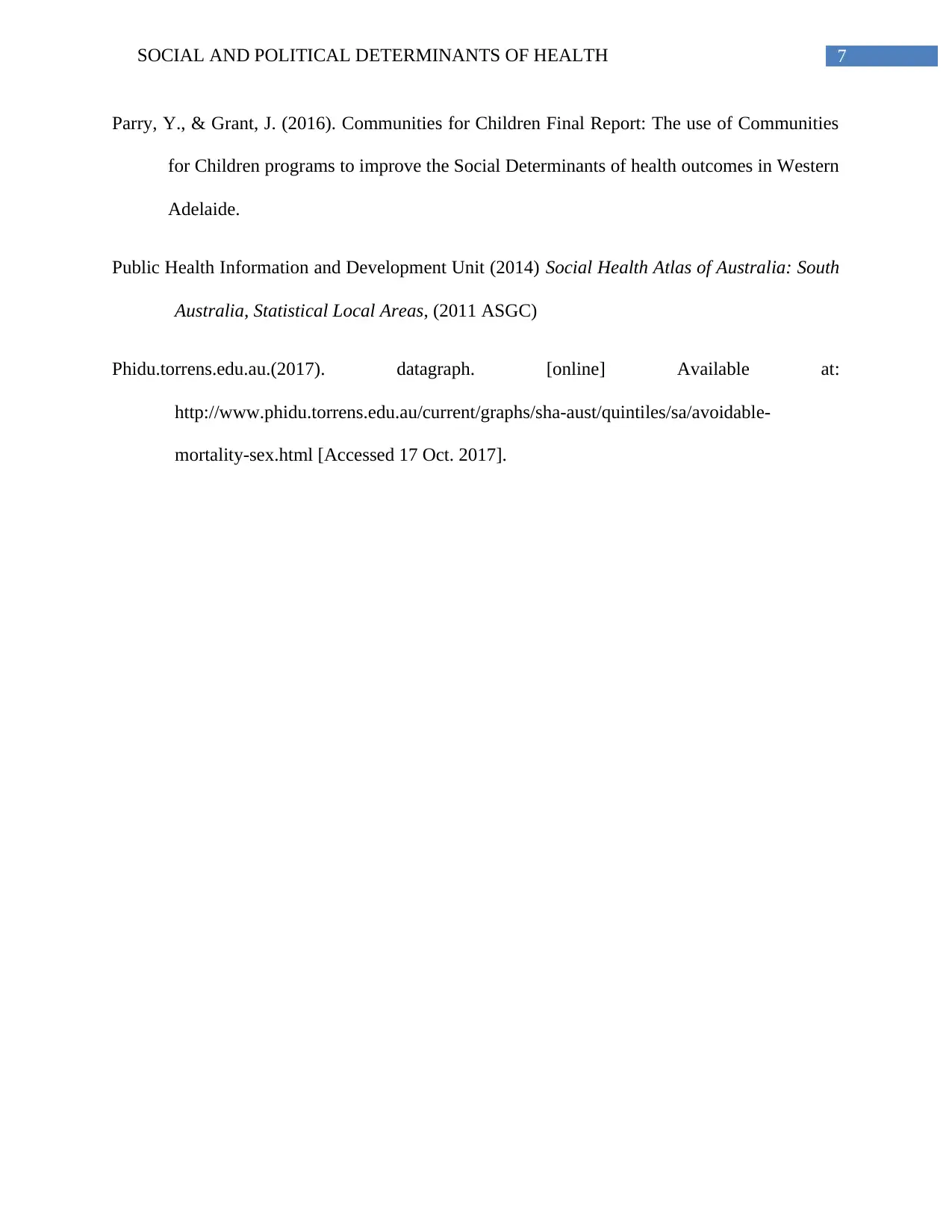
7SOCIAL AND POLITICAL DETERMINANTS OF HEALTH
Parry, Y., & Grant, J. (2016). Communities for Children Final Report: The use of Communities
for Children programs to improve the Social Determinants of health outcomes in Western
Adelaide.
Public Health Information and Development Unit (2014) Social Health Atlas of Australia: South
Australia, Statistical Local Areas, (2011 ASGC)
Phidu.torrens.edu.au.(2017). datagraph. [online] Available at:
http://www.phidu.torrens.edu.au/current/graphs/sha-aust/quintiles/sa/avoidable-
mortality-sex.html [Accessed 17 Oct. 2017].
Parry, Y., & Grant, J. (2016). Communities for Children Final Report: The use of Communities
for Children programs to improve the Social Determinants of health outcomes in Western
Adelaide.
Public Health Information and Development Unit (2014) Social Health Atlas of Australia: South
Australia, Statistical Local Areas, (2011 ASGC)
Phidu.torrens.edu.au.(2017). datagraph. [online] Available at:
http://www.phidu.torrens.edu.au/current/graphs/sha-aust/quintiles/sa/avoidable-
mortality-sex.html [Accessed 17 Oct. 2017].
1 out of 8
Related Documents
Your All-in-One AI-Powered Toolkit for Academic Success.
+13062052269
info@desklib.com
Available 24*7 on WhatsApp / Email
![[object Object]](/_next/static/media/star-bottom.7253800d.svg)
Unlock your academic potential
Copyright © 2020–2025 A2Z Services. All Rights Reserved. Developed and managed by ZUCOL.





